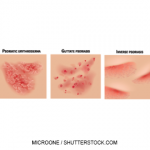But the study also points to the ongoing risk of severe infection. Researchers found 5.51 such infections per 100 person-years. The 30-day risk of serious infection leading to mortality in RA was 10%.
Other work has highlighted the infection risk posed by steroids. A 2017 study found that low-dose steroids (7.5 mg or lower) resulted in 6.4 hospitalized infectious events compared with more than double—13.3 events—for high-dose steroids (over 7.5 mg).3
“Steroids clearly impact mortality associated with infection in RA patients,” Dr. Lortholary said.
RA patients also face an increased risk of herpes zoster and herpes zoster-related stroke, with infected RA patients at 27% increased risk, according to a 2017 study.4 But studies have yielded mixed results on whether anti-TNF drugs contribute to the risk of zoster infection, Dr. Lortholary noted.
Researchers have tried to pinpoint factors that may put patients at risk of serious infections on biologics. In a French registry study of 1,491 patients, REGATE, every 10 years of additional age heightened the risk of serious infection by 14% in RA patients treated with anti-IL6 agent tocilizumab. Other significant predictors included treatment in combination with leflunomide. The incidence of 4.7 serious infections per 100 patient-years compared with about four that have been seen with abatacept, five with rituximab and three to six seen with anti-TNF agents, Dr. Lortholary said.5
Prevention
Preventing infection in patients on biologic therapy can be as straightforward as avoiding common hazards, such as pets and exposure on the job, he said. If they smoke, patients should stop to reduce their risk of respiratory tract infections.
Of course, vaccinations are helpful, but can be blunted by biologics. Rituximab can reduce the efficacy of the flu vaccine, and the vaccine also provides less protection in patients on abatacept, he said.
Dr. Lortholary said he hoped for a better team approach between infectious disease experts and rheumatologists in tackling infections in RA.
“We have to face an increasing number of therapeutic families and indications, so be aware that it’s really a challenge for us to follow all these different directions,” he said. “I hope we develop guidance and more collaboration with rheumatologists with these patients treated with biologics.”
Thomas R. Collins is a freelance writer living in South Florida.
References
- Kourbeti IS, Ziakas PD, Mylonakis E. Biologic therapies in rheumatoid arthritis and the risk of opportunistic infections: A meta-analysis. Clin Infect Dis. 2014 Jun;58(12):1649–1657.
- Rutherford AI, Patarata E, Subesinghe S, et al. Opportunistic infections in rheumatoid arthritis patients exposed to biologic therapy: Results from the British Society for Rheumatology Biologics Register for Rheumatoid Arthritis. Rheumatology (Oxford). 2018 Jun 1;57(6):997–1001.
- Schenfeld J, Iles J, Trivedi M, et al. Dose relationship between oral glucocorticoids and tumor necrosis factor inhibitors and the riskof hospitalized infectious events among patients with rheumatoid arthritis. Rheumatol Int. 2017 Jul;37(7):1075–1082.
- Liao TL, Lin CH, Chen HH, et al. Significant associations of neurological complications of herpes zoster with stroke in rheumatoid arthritis patients. J Am Heart Assoc. 2017 Jul 19;6(7).
- Morel J, Constantin A, Baron G, et al. Risk factors of serious infections in patients with rheumatoid arthritis treated with tocilizumab in the French Registry REGATE. Rheumatology (Oxford). 2017 Oct 1;56(10):1746-1754.



